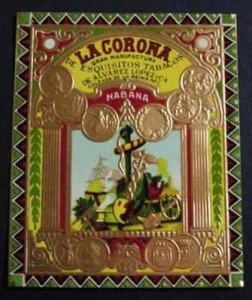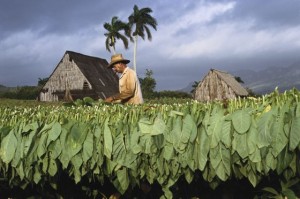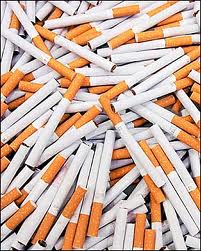The benefits of Cuban snuff did you recognize him as the best in the world and this recognition to our odd product placed on the goal of every good smoker.
.. The peculiarities of each market and the taste of the cigar smokers made, already distinguished by their origin, began to qualify from the area where it was harvested.
Several growing areas exist in Cuba. The Vuelta Abajo region corresponds to the western province of Pinar del Rio. Part of an imaginary line drawn from north to south, from Consolacion to Rio Hondo, through Herradura, and make North Consolation, Mantua, Pinar del Rio, Vinales, Guane, San Juan y Martinez and San Luis South Consolation . This territory is subdivided into five divisions: North Coast, Lomas, Llano, Sale-Guane and South Coast. The terms of San Juan y Martinez and San Luis correspond to Llano, and there are the most famous world vegas snuff.
Semi Vuelta area also is located in the province of Pinar del Rio, from Herradura to Las Martinus, while the party area is located in Havana. They form part of the territories of Alquízar, Bejucal, Caimito of Guayabal, Guines, Güira de Melena, Health, Madruga, San Antonio de los Baños and Santiago de las Vegas and also Guanajay and Artemis.
The area is the largest tobacco Vuelta Arriba and Remedios. It spans three provinces regions of central and arrives at Ciego de Avila and Camagüey. In the eastern zone are areas of Alto Songo, Bayamo, Jiguaní, Mayari and Sagua de Tánamo.
The snuff harvested in each of these areas has its peculiarities. In Vuelta Abajo are obtained for thin layers of high quality cigar bands. The Semi Vuelta produces good capes. The productions of the Vuelta Arriba, high demand in the U.S. market before the implementation of the blockade., They still demand abroad and domestic trade, as the crops of the eastern zone.
CIGARETTE APPEARS
When spread over the world the habit of snuff, various modalities established preferences for consumption. The snuff and pipe predominated in the early days. Later, the twisted snuff. There were times when it was in vogue in the habit of chewing the leaves, either in their natural state or in the form of rolls or tablets andullo call that was nothing to snuff pressed sheets that are added to some other substance. Cigarettes would be the last son of snuff to make their appearance.
Cigarette Debuts in Cuba as a cottage industry. It was up to porters, slaves, prisoners and soldiers to make it in their spare time and sold it then.
In the early days of this industry in Havana, moves, between legend and reality, a character known as Pito Diaz. He was born in Mexico and established a currency exchange house in the street of the Cradle, name given to Wall in the section between Crafts and Merchants. In front of his establishment Pito stood in a large pan, with lemon juice and other ingredients, cleaned gold coins, making them shiny and attractive. His clients included not snuff few growers who traded for gold silver coins received in settlement of their transactions. No one knows how a good day, without leaving the house change, Pito extended its business to the manufacture of cigarettes. And that was until he disappeared, he had completely mad.
Jose Mendoza continued business Whistle Diaz. It supported its strong economic position and established a factory in Obrapía Street. So cigarettes are transported in baskets to the place of sale. Mendoza took a turn for distribution. It began to fend for animal-drawn carts, which allowed his productions reach neighboring towns of the capital.
Jose Garcia and his wife, other factory owners, subsequently made an important contribution to market cigarettes. Endowed the retailers or newsstands stained glass for sale of the product. Elaborated marriage in their factory, first in the Morro Davit then Bishop Street, cigarettes of various types according to their shape, were called long, short, fat and thin.
Is Jose Morejon, Owner Loyalty, manufactures tobacco and cigarettes, who introduced luxury in the presentation of their products and uses for primea once the packs printed.
It would, however, Luis Susini who revolutionized the cigarette industry in Cuba to enter the steam engine factory in Honesty, established in Cuba Street Sun Initiative corner that allowed a daily production of over two and a half million units.
In 1840 there were in Havana several cigarette manufacturers, related mostly to snuff mills. A century after the country operating in 26 factories, which employed almost 2500 workers, of whom more than 860 were women. In 1951 he produced on the Island 512 400 000 packs of 16 cigarettes each. And were exported 1.24 million. Always the cigarette has been a supplier industry domestic consumption. Does not have that product in the foreign market demand favoring the snuff, manufactured or branch.
This is a story, not the story, a genuinely Cuban industry. Much satisfy the author know that by reading it, the person learned something new and your satisfaction would be greater if he knew also enjoyed it. It remains for me to give advice. Say no to smoking. If you have never smoked, do not. And if you smoke, quit because smoking will always count. It’s hard trying. But remember that the longest journey begins with the first step.
Sources:CiroBianchiRoss/FOrtiz/Internetphotos/www.theCubanHistory.com
CIGARS AND CIGARETTES, a Cuban Story
The Cuban History, Arnoldo Varona, Editor
TABACOS Y CIGARRILLOS, UNA HISTORIA CUBANA
Las bondades del tabaco cubano hicieron que se le reconociese como el mejor del mundo y ese reconocimiento situó a nuestro impar producto en la meta de todo buen fumador.
.. Las peculiaridades de cada mercado y el gusto de los fumadores hicieron que el habano, distinguido ya por su procedencia, comenzara a clasificarse a partir de la zona donde había sido cosechado.
Varias zonas de cultivo existen en Cuba. La de Vuelta Abajo corresponde a la región más occidental de la provincia de Pinar del Río. Parte de una línea imaginaria, trazada de norte a sur, desde Consolación hasta Río Hondo, pasando por Herradura, y la conforman Consolación del Norte, Mantua, Pinar del Río, Viñales, Guane, San Juan y Martínez, San Luis y Consolación del Sur. Este territorio se subdivide a su vez en cinco subzonas: Costa Norte, Lomas, Llano, Remates-Guane y Costa Sur. Los términos de San Juan y Martínez y San Luis corresponden al Llano, y allí se encuentran las más afamadas vegas de tabaco del mundo.
La zona de Semi Vuelta se ubica asimismo en la provincia pinareña, desde Herradura hasta Las Martinas, en tanto que la zona de Partido se localiza en La Habana. Forman parte de ella los territorios de Alquízar, Bejucal, Caimito del Guayabal, Güines, Güira de Melena, La Salud, Madruga, San Antonio de los Baños y Santiago de las Vegas y también los de Guanajay y Artemisa.
La zona tabacalera más extensa es la de Vuelta Arriba o Remedios. Se extiende por regiones de las tres provincias centrales y llega a Ciego de Ávila y Camagüey. A la zona de Oriente corresponden las áreas de Alto Songo, Bayamo, Jiguaní, Mayarí y Sagua de Tánamo.
El tabaco cosechado en cada una de esas zonas tiene sus peculiaridades. En Vuelta Abajo se obtienen las capas más finas para las vitolas de alta calidad. La Semi Vuelta produce buenos capotes. Las producciones de la Vuelta Arriba, muy solicitadas por el mercado norteamericano antes de la implantación del bloqueo., siguen teniendo demanda en el exterior y en el comercio nacional, al igual que las cosechas de la zona de Oriente.
APARECE EL CIGARRILLO
Al extenderse por el mundo el hábito del tabaco, las preferencias establecieron modalidades diversas para su consumo. El rapé y la pipa predominaron en los primeros tiempos. Más tarde, el tabaco torcido. Hubo momentos en que estuvo muy en boga la costumbre de masticar las hojas, bien en su estado natural o en forma de rollos o tabletas llamadas andullo, que no era otra cosa que hojas de tabaco prensadas a la que se añadía alguna que otra sustancia. Sería el cigarrillo el último hijo del tabaco en hacer su aparición.
El cigarrillo debuta en Cuba como una industria casera. Estaba en manos de porteros, esclavos, reclusos y soldados que lo confeccionaban en sus horas libres y lo vendían luego.
En los comienzos de esta industria en La Habana, se mueve, entre la leyenda y la realidad, un personaje conocido como Pito Díaz. Había nacido en México y estableció una casa de cambio de monedas en la calle de la Cuna, nombre que se daba a Muralla en el tramo comprendido entre Oficios y Mercaderes. Frente a su establecimiento situó Pito una gran paila en la que, con zumo de limón y otros ingredientes, limpiaba monedas de oro, haciéndolas relucientes y más atractivas. Entre sus clientes figuraban no pocos cosecheros de tabaco, que cambiaban por oro las monedas de plata que recibían en pago de sus transacciones. No se sabe cómo un buen día, sin abandonar la casa de cambio, Pito extendió su negocio a la fabricación de cigarrillos. Y en eso estuvo hasta que desapareció; había enloquecido totalmente.
José Mendoza siguió el negocio de Pito Díaz. Lo respaldaba su sólida posición económica y estableció una fábrica en la calle Obrapía. Entonces los cigarrillos se transportaban en canastas hasta los lugares de expendio. Mendoza dio un giro a su distribución. Empezó a valerse para ello de carros de tracción animal, lo que le permitía que sus producciones alcanzaran los pueblos limítrofes de la capital.
José García y su esposa, propietarios de otra fábrica, hicieron posteriormente un aporte importante al mercado de los cigarrillos. Dotaron a los comerciantes al por menor de vidrieras o estanquillos para la venta del producto. Elaboraba el matrimonio en su fábrica, situada primero en el Pescante del Morro y luego en la calle Obispo, cigarrillos de diversos tipos que, según su conformación, se denominaban largos, cortos, gordos y finos.
Es José Morejón, propietario de La Lealtad, fabrica de tabacos y cigarrillos, quien introduce el lujo en la presentación de sus producciones y utiliza por primea vez las cajetillas impresas.
Sería, sin embargo, Luis Susini quien revolucionaría la industria del cigarrillo en Cuba al introducir la máquina de vapor en su fábrica La Honradez, establecida en la calle Cuba esquina a Sol. Iniciativa que le permitió una producción diaria superior a los dos millones y medio de unidades.
En 1840 existían en La Habana varias fábricas de cigarrillos, anexas en su mayoría a fábricas de tabaco. Un siglo después funcionaban en el país 26 fábricas, que daban empleo a casi 2 500 obreros, de los cuales más de 860 eran mujeres. En 1951 se produjeron en la Isla 512 400 000 cajetillas de 16 cigarrillos cada una. Y se exportaron 1 240 000. Siempre la del cigarrillo ha sido una industria abastecedora del consumo doméstico. No tiene ese producto en el mercado extranjero la demanda que favorece al tabaco, manufacturado o en rama.
Esta es una historia, no la historia, de una industria genuinamente cubana. Mucho satisfaría al autor saber que al leerla, el interesado aprendió algo nuevo y su satisfacción sería mayor si supiera que además la disfrutó. Solo me resta dar un consejo. Diga no al hábito de fumar. Si nunca ha fumado, no lo haga. Y si fuma, deje de hacerlo porque el fumar siempre le pasará la cuenta. Es difícil proponérselo. Pero recuerde que el camino más largo comienza por el primer paso.
Sources:CiroBianchiRoss/FOrtiz/Internetphotos/www.theCubanHistory.com
CIGARS AND CIGARETTES, a Cuban Story
The Cuban History, Arnoldo Varona, Editor



 CIGARS AND CIGARETTES, a Cuban Story * TABACOS Y CIGARRILLOS, una Historia Cubana.
CIGARS AND CIGARETTES, a Cuban Story * TABACOS Y CIGARRILLOS, una Historia Cubana.



